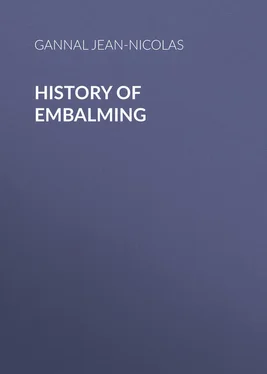Jean-Nicolas Gannal - History of Embalming
Здесь есть возможность читать онлайн «Jean-Nicolas Gannal - History of Embalming» — ознакомительный отрывок электронной книги совершенно бесплатно, а после прочтения отрывка купить полную версию. В некоторых случаях можно слушать аудио, скачать через торрент в формате fb2 и присутствует краткое содержание. Жанр: foreign_antique, foreign_prose, на английском языке. Описание произведения, (предисловие) а так же отзывы посетителей доступны на портале библиотеки ЛибКат.
- Название:History of Embalming
- Автор:
- Жанр:
- Год:неизвестен
- ISBN:нет данных
- Рейтинг книги:5 / 5. Голосов: 1
-
Избранное:Добавить в избранное
- Отзывы:
-
Ваша оценка:
- 100
- 1
- 2
- 3
- 4
- 5
History of Embalming: краткое содержание, описание и аннотация
Предлагаем к чтению аннотацию, описание, краткое содержание или предисловие (зависит от того, что написал сам автор книги «History of Embalming»). Если вы не нашли необходимую информацию о книге — напишите в комментариях, мы постараемся отыскать её.
History of Embalming — читать онлайн ознакомительный отрывок
Ниже представлен текст книги, разбитый по страницам. Система сохранения места последней прочитанной страницы, позволяет с удобством читать онлайн бесплатно книгу «History of Embalming», без необходимости каждый раз заново искать на чём Вы остановились. Поставьте закладку, и сможете в любой момент перейти на страницу, на которой закончили чтение.
Интервал:
Закладка:
“At the Canaries, they do not limit themselves always to placing the mummies in grottoes; they elevated special tombs to certain distinguished dead. These privileged dead, dressed in their garment, called tamareo, were placed upon elevated planks of pine wood, with the head turned towards the north; they afterwards constructed above, a monument of hard stone, pyramidal in form, and often very high. Many catacombs are known to exist in Teneriffe; the most celebrated is that of Baranco de Herque, between Arico and Guimar, in the Abona country: it was discovered during the time that Clarijo wrote his Noticias . He states that they there met with more than a thousand mummies, whilst in other cases only three or four hundred had been found at a time. From hence they brought the xaxos, which are in the cabinet of the King of Spain, and the two which M. de Chastenet-Puysegur sent in 1776, to the Garden of Plants: one of them unfortunately wants the feet.”
We abstain from all reflection on the recital which precedes. Their analogy to the Egyptian process will occur of itself to the mind of the reader, in the description which follows. Nevertheless, we ought to indicate a fact observed of two Guanch mummies; a fact omitted in the preceding description.
M. Jouannet, a modest and laborious investigator, has proved, that two Guanch mummies that were in his possession, had the eyes, nose, and mouth, filled with bitumen, like some of the Egyptian mummies. The skins which enveloped them were carefully closed, and nothing indicated that the bitumen was an addition posterior to embalming.
CHAPTER IV.
EMBALMING AMONG THE ANCIENT EGYPTIANS
Since the ignorance we are in, relative to the language of this great nation, places it out of our power to know, of ourselves, the causes and processes for the preservation of dead bodies, let us follow the recital of ancient authors, let us endeavour to detect, not by the imagination, but by positive facts, by the study of invariable exterior conditions, the different data of the question of embalming among the Egyptians.
In the first place, if we make allowance for all that the successive perfection of the arts, luxury, or the love of distinction could add to simple preservation, we shall arrive, with Rouelle, to this conclusion, that the work of embalming is reduced to two essential parts: first, the drying of the body, that is to say, removing the fluids and grease which they contain; secondly, to protect the body thus prepared, from external humidity and contact of the air. We have already seen all the aid which they derived from their climate to fulfil the first condition: a detailed description will teach us what their industry enabled them to add to it. As to the second, the nature of their caverns powerfully contributed.
These vast cavities, says Pelletan, sheltered from the inundations of the Nile, have, without doubt, originally furnished the materials for the monuments of Thebes, and the architects of the day thus hollowed out the tombs of families in elevating their palaces. Their whole surface, from the entrance, even to the deepest recesses of these dark excavations, are covered with sepultures and fresco paintings. Each framed subject forms so many little pictures which touch each other, and the figures of which are not more than two or three inches in height, so that the whole extent of these double walls, the development of which is incalculable, has been the object of minute labour. The sculptures are in bas-relief, and covered with equable tints, but lively, and in very good preservation . The points of rock unconnected with the work, have been covered with a composition perfectly solid, and so durable, that, as yet, no other degradation is observable, than that produced by the efforts of some travellers to carry off fragments of it . Perspective is always wanting in these pictures; the bodies are viewed in full, the faces in profile; but the design is pure and the proportions just; we find nothing to indicate ignorance in the artist; which presumes for the Egyptians, if not great perfection in the arts, at least a great popularity in their practice. The subject of these paintings are domestic scenes, and generally followed by a funeral procession; from whence it may be inferred, that they refer to the life of the man enclosed in each of the lateral niches. The temperature of the caverns is 20° R.
It appeared to us convenient thus to give a summary of the conditions of drying, and of the ulterior preservation, before presenting descriptions which have been more or less accurately transmitted to us, of the part that man has had in this operation.
Herodotus, Diodorus Sicculus, and Porphyrus, who have written with the greatest detail on the funerals of the Egyptians, will afford us the first instructions.
Herodotus. “Mourning and funerals are conducted after this manner: when a man of consideration dies, all the women of his house ( oiketes ) cover the head and even the face with mud; they leave the deceased in the house, girdle the middle of their bodies, bare the bosom, strike the breast, and overrun the city, accompanied by their relations. On the other side, the men also girdle themselves and strike their breasts; after this ceremony, they carry the body to the place where it is to be embalmed.”
The following, after Diodorus Sicculus, (book 1st, vol. i. p. 102, § xcii.) is the ceremony of sepulture among the Egyptians: “The relatives fix the day for the obsequies, in order that the judges, the relations, and friends of the dead may be present, and they characterize it by saying, he is going to pass the lake; afterwards the judges, to the number of more than forty arriving, they place themselves in the form of a semi-circle beyond the lake. A batteau approaches the shore, carrying those who have charge of this ceremony, and in which is a sailor, whom the Egyptians name in their language Charon . They say, further, that Orpheus having remarked this custom in his voyage in Egypt, took occasion from it to imagine the fable of hell, imitating a portion of these ceremonies, and adding to them others of his own invention. Before placing in the batteau the coffin containing the body of the deceased, it is lawful for each one present to accuse him. If they prove that he has led a sinful life, the judges condemn him, and he is excluded from the place of his sepulture. If it appear that he has been unjustly accused, they punish the accuser with severity. If no accuser presents himself, or if the one who does so is known as a calumniator, the relatives, putting aside the signs of their grief, deliver an eulogium on the deceased without mentioning his birth, as is practised among the Grecians, because they considered all Egyptians equally noble. They enlarge on the manner in which he has been schooled and instructed from his childhood; upon his piety, justice, temperance, and his other virtues since he attained manhood, and they pray the Gods of hell to admit him into the dwelling of the pious. The people applauded and glorified the dead who were to pass all eternity in the abodes of the happy. If any one has a monument destined for his sepulture, his body is there deposited; if he has none, they construct a room in his house, and place the bier upright against the most solid part of the wall. They place in their houses those to whom sepulture has not been awarded, either on account of crimes, of which they are accused, or on account of the debts which they may have contracted; and it happens sometimes in the end that they obtain honourable sepulture, their children or descendants becoming rich, pay their debts or absolve them.” Orpheus communicated to the Greeks these usages of the Egyptians, applied to hell. Homer, following in his steps, adorned his poetry with them: “ Mercury ,” says he, “his wand in his hand, convoked the souls of the candidates.” And further on: “They traversed the ocean, passed near Leucadia, entered by the gate of the sun, ( Heliopolis ,) the country of dreams, and soon attained the fields of Asphodelia, where inhabit the souls who are the images of death.”
Читать дальшеИнтервал:
Закладка:
Похожие книги на «History of Embalming»
Представляем Вашему вниманию похожие книги на «History of Embalming» списком для выбора. Мы отобрали схожую по названию и смыслу литературу в надежде предоставить читателям больше вариантов отыскать новые, интересные, ещё непрочитанные произведения.
Обсуждение, отзывы о книге «History of Embalming» и просто собственные мнения читателей. Оставьте ваши комментарии, напишите, что Вы думаете о произведении, его смысле или главных героях. Укажите что конкретно понравилось, а что нет, и почему Вы так считаете.












